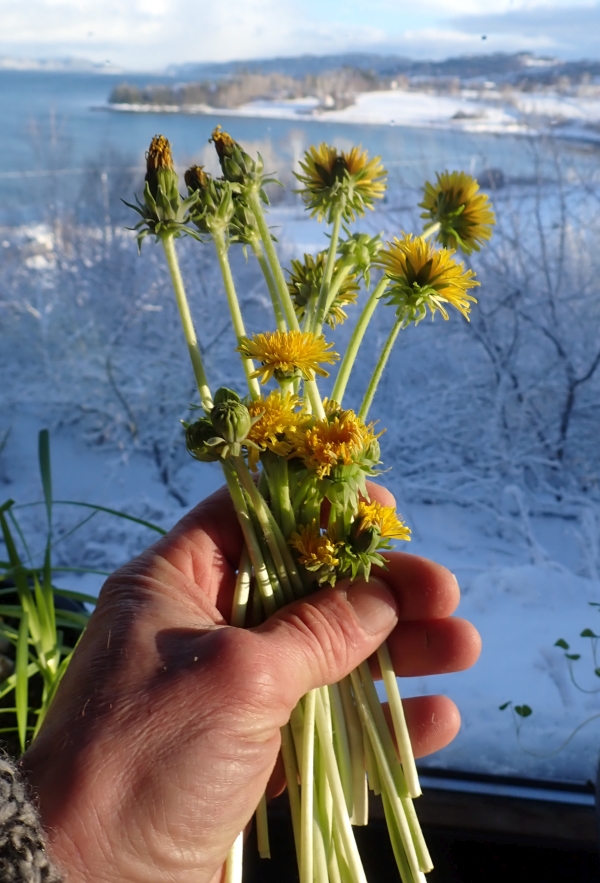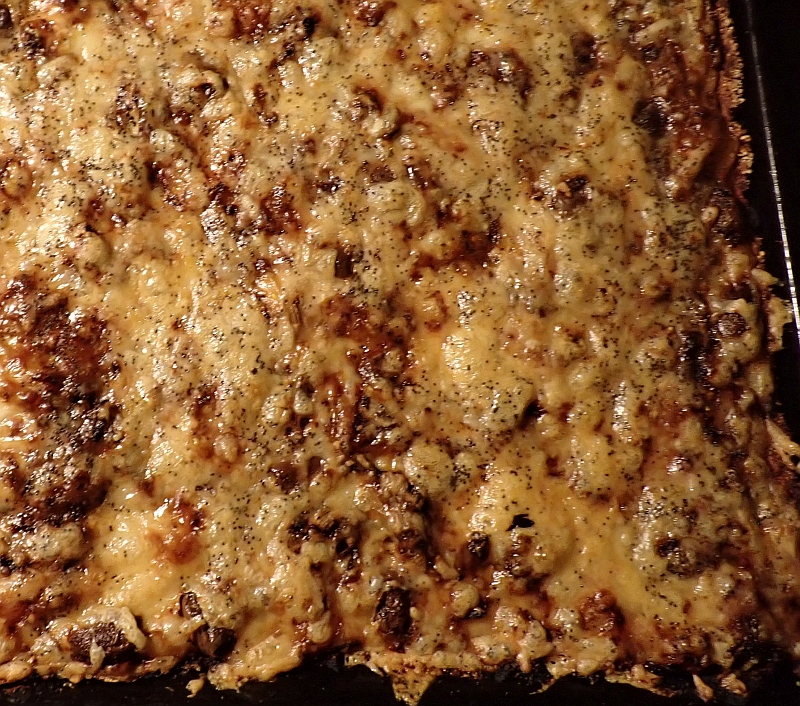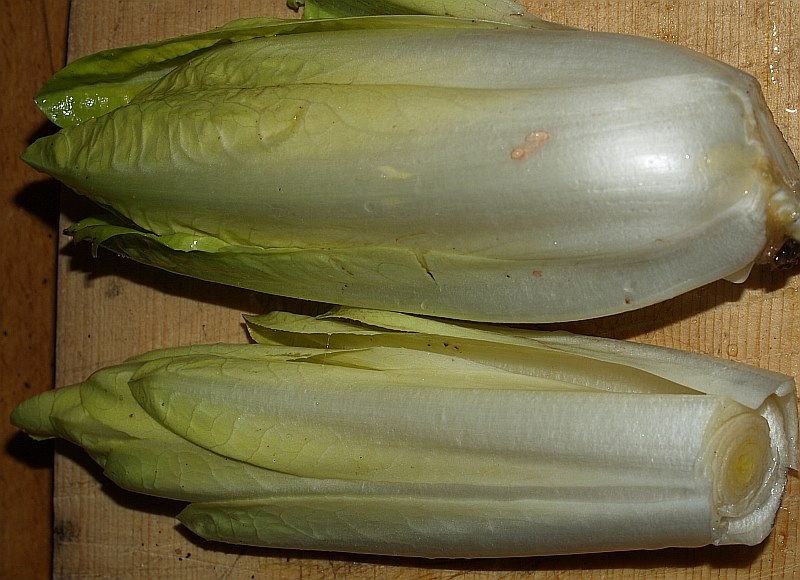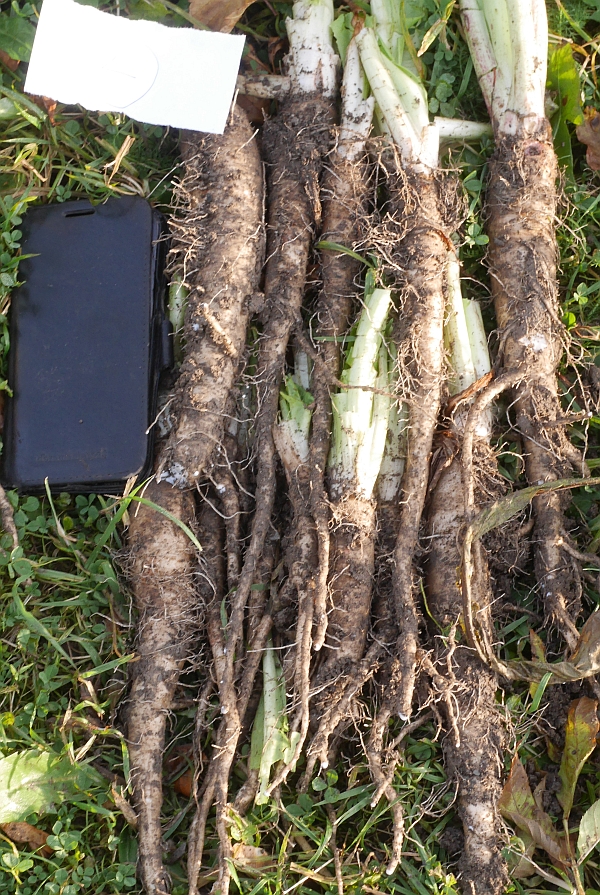Somebody asked me to show how I force veggies indoors in winter, so here you have a link to a short video showing what is available at the moment!
At this time of year, most of our leafy greens used in salads and cooking are either harvested from the forcing pots shown in the video or directly from the cold cellar under the house. Here is a mixture of perennials, biennials and annuals. Still looking for a good perennial chicory for forcing. See the list of plants shown below.
Follow the link to the video.
Witloof Festive Chicory (sikori / julesalat)
Witloof Væres Venner mix (my own selection from the community garden based on several varieties from various gene banks)
Hristo’s onion (Allium flavescens x nutans?)
Kandahar cress (karse) from the Experimental Farm Network (seed harvested in the community garden)
Wild buckwheat / vill bokhvete (seed harvested in The Edible Garden) Garlic bulbil sprouts / spirte hvitløk bulbiller
Nodding onion / prærieløk (Allium cernuum)
Dandelion / løvetann
Tag Archives: Witloof
Dandelion scape, bud and flower omelette
Sorry, but I ceremoniously sacrificed all the dandelion flowers, buds and scapes for a delicious omelette today…and what a wonderful view they had on their last day on earth!
Also in the dandeliomelette was chicory “Witloof” sprouts, an old Finnish shallot, garlic, thyme and the last of the wild buckwheat sprouts (løvetann, sikori,sjalott, hvitløk, timian og vill bokhvete)






Seed saving talk weekend
Thanks to KVANN (Norwegian Seed Savers) colleague Andrew McMillion for coming up to Trondheim to give his seed saving course for local KVANN and Væres Venner Community Garden members!

…and there was time for a Malvik visit, a seed saving and breeding chat, a tour of my seed boxes and a little salad with Witloof chicory and dandelion pizza.
 Salad ingredients: Celery, three chicory varieties, dandelion (including one flower), carrot, Japanese yams, Allium cernuum and Hablitzia (from the garden), Hristo’s onion (Allium flavescens x nutans?), oca (2 varieties), apple (Aroma), horseradish shoots, garlic, chives, wild buckwheat shoots and turnip “Målselvnepe”
Salad ingredients: Celery, three chicory varieties, dandelion (including one flower), carrot, Japanese yams, Allium cernuum and Hablitzia (from the garden), Hristo’s onion (Allium flavescens x nutans?), oca (2 varieties), apple (Aroma), horseradish shoots, garlic, chives, wild buckwheat shoots and turnip “Målselvnepe”

…and my seed archive:
February salad
Lunch salad had the following ingredients;
From the garden:
Allium scorodoprasum / sand leek / bendelløk (shoots)
Allium cernuum / nodding onion / prærieløk (bulbs and leaves)
Hablitzia tamnoides / Caucasian spinach / stjernemelde (shoots)
From the cellar:
Brassica oleracea / perennial kale / flerårig kål (new leaves)
Cichorium intybus “Witloof” / chicory / sikori (shoots)
Taraxacum spp. /dandelion /løvetann (blanched cellar shoots)
Apium graveolens / celery / selleri (new and old leaves from stored celery plants)
Brassica rapa / turnip / nepe (roots)
Brassica rapa / turnip / nepe (leaf shoots)
Daucus carota / carrot / gulrot
From the living room:
Allium nutans (forced shoots)
Allium sativum / garlic / hvitløk (forced bulbils)
Taraxacum spp. / dandelion / løvetann (forced green leaves)
(served with feta cheese, olive oil, olives, salt and pepper)

Cellar and Garden Greens: 6th April 2022
The greens that went into last night’s wholegrain spelt quiche are listed below the picture! CELLAR: Dystaenia takesimana shoots; Forced hogweed (bjørnekjeks) shoots (Heracleum spp.); Forced Taraxacum (dandelion / løvetann); nederst til høyre: Witloof chicory (sikkori); øverst til høyre: swiss chard (mangold)
CELLAR: Dystaenia takesimana shoots; Forced hogweed (bjørnekjeks) shoots (Heracleum spp.); Forced Taraxacum (dandelion / løvetann); nederst til høyre: Witloof chicory (sikkori); øverst til høyre: swiss chard (mangold)
GARDEN: Various hybrid onions (Allium senescens x nutans) and Hablitzia tamnoides (Caucasian spinach / stjernemelde)
Root Chicory Trials 2021 at Være
One of the experiments this year in the KVANN (Norwegian Seed Savers) trial gardens at Væres Venner in Trondheim has been a comparison of different root chicories. These have 3 main uses:
Witloof (literally “white leaf”) or forcing chicories used for producing chicons, also known as Belgian or French endive (forced from the roots in the dark, usually in winter. to reduce the bitterness);
Root chicories where the root is used as a vegetable, popular in winter in Italy;
Coffee chicories are also in the group root chicories and sometimes the same varieties harvested more mature and used as coffee surrogate (ground and roasted).
There are hundreds of varieties of chicories with multiple other uses. Common for all here in the north is that they are relatively easy to grow with few pests and diseases, thus easier to grow organically than for example the cabbage family. However, they are almost never used here in Norway. In Norway’s largest FB group on vegetables “Grønnsaksdyrking i Hele Norge” with 36,000 members there is only one mention of chicory)(sikkori) and that more as a wild plant than something you would cultivate.
This is partly because most have been selected for a very different (Mediterranean) climate and some go to seed (bolt) in the first year which significantly lowers yields. Witloof chicories have, however, largely been improved further north (Belgium and France) and my experience has shown that these varieties only occasionally bolt (out of several hundred plants grown this year, none bolted!).
 The chicory bed just before harvest. There are 9 varieties along the 1.2m wide raised bed.
The chicory bed just before harvest. There are 9 varieties along the 1.2m wide raised bed.
I sourced different varieties of root chicories from the German genebank IPK Gatersleben with the objective to select a good variety in the two main groups for my area (I had previously had reasonably good experience growing witloof chicories for forcing in winter; see the picture below). I wanted also to explore if it is possible to be self-sufficient in seed. As part of the seed saving process, roots need to be overwintered and grown to flowering in the second year. Hardiness of chicories varies a lot between varieties and I therefore overwinter roots in my cold cellar, but plan also later to test winter hardiness outside. Some chicories can also perennialize like the wild species and this is a secondary project to select high yielding perennial and hardy chicories. Another great characteristic of chicories and side-effect of seed saving is that the beautiful chicory flowers are very popular with pollinators and a number of selections with different flower colours are also available for growing as an ornamental. This is indeed a great combination plant that I term an edi-ento-mental (edible, good for the pollinators and ornamentally valuable too).
See the various flower variants I’ve grown in this post: https://www.edimentals.com/blog/?p=18650 Winter forced Witloof chicons from my cold cellar in mid¨-February
Winter forced Witloof chicons from my cold cellar in mid¨-February
Chicory in flower in my garden
I was pleased with the yield, which was better than I’ve experienced in my shady garden at home. The fact that the roots are irregular in size is probably at least in part due to the fact that the spacing between the roots was a little irregular (I will try for a more even spacing next year). Witloof chicory Prezo RZ performed well
Witloof chicory Prezo RZ performed well Witloof chicory Extra Vroege Mechelse had a lot of forking roots
Witloof chicory Extra Vroege Mechelse had a lot of forking roots
We’ve grown 4 varieties of Witloof forcing chicories including Witloof Prezo RZ, Witloof Extra Vroege Mechelse (Early) and Witloof Dobbel Blank. In the video there are 9 varieties shown and the Witloofs are #2, 7, 8 and 9. There are some nice size roots and I plan to grown on the largest 20-25 or so roots for seed, which will then be made available to KVANN members. Nice sized roots of the edible root variety Radici di Soncino
Nice sized roots of the edible root variety Radici di Soncino
The root chicory Radici di Chiavara
There were two varieties of root chicory and both gave good yields. I will probably grow again next year in larger quantity (the descriptions are taken from Stephen Facciola’s Cornucopia II)
Radici di Chiavara (Chiavari)
Grown primarily for its root, although the leaves are also used and have a good flavor. The root is thick-collared, creamy white and uniform. Grows over a long season, from early spring until late fall. To prepare, scrape and boil the root until tender. Slice thinly and serve with vinaigrette, or it can be rolled in bread crumbs, deep fried and served with lemon and parsley.
Radici di Soncino(Radison)
Long, narrow roots with creamy white skin and flesh; rather bitter. May be harvested anytime from autumn until the following spring. Popular in Italy where it is considered very healthful and is cooked and eaten in many ways.
Below is a video showing all the harvested roots:
